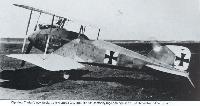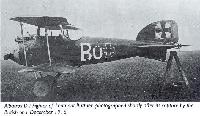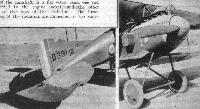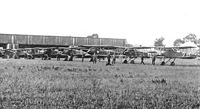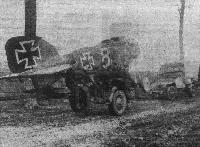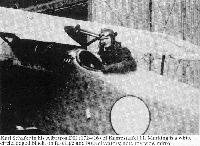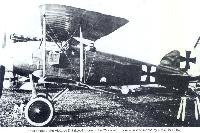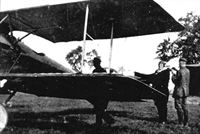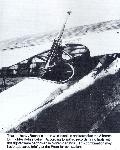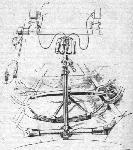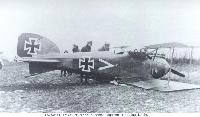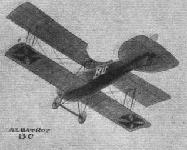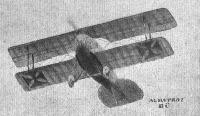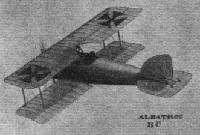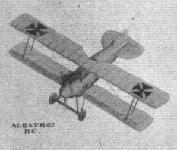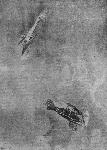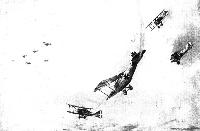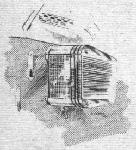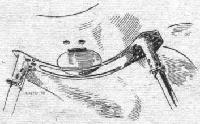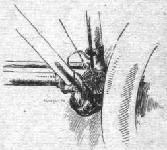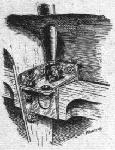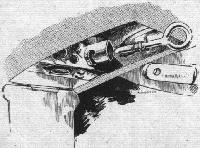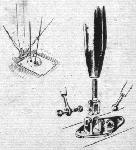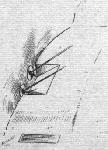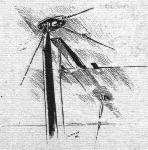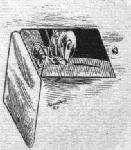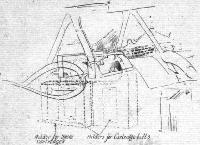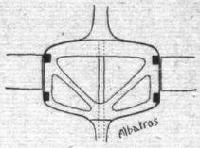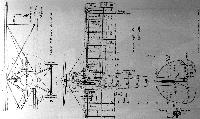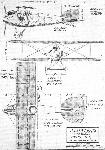
Описание
Страна: Германия
Год: 1916
Истребитель
Варианты
- Albatros - D.I/D.II - 1916 - Германия
- Albatros - W.4 - 1916 - Германия
- Albatros (Oeffag) - D.II / D.III - 1917 - Австро-Венгрия
- Albatros - D.IV - 1917 - Германия
- В.Кондратьев Самолеты первой мировой войны
- O.Thetford, P.Gray German Aircraft of the First World War (Putnam)
- W.Green, G.Swanborough The Complete Book of Fighters
- J.Herris Albatros Aircraft of WWI. Vol.4: Fighters (A Centennial Perspective on Great War Airplanes 27)
- Журнал Flight
-
В.Кондратьев - Самолеты первой мировой войны
Альбатрос D.I, пилот Отто Хёне, октябрь 1918г.
-
В.Кондратьев - Самолеты первой мировой войны
Альбатрос D.I, пилот - лейтенант О.Хёне, осень 1918г.
-
J.Herris - Albatros Aircraft of WWI. Volume 4: Fighters /Centennial Perspective/ (27)
Albatros D.I 391/16 in its original markings as flown by Lt. Karl Buttner of Jasta 2.
-
J.Herris - Albatros Aircraft of WWI. Volume 4: Fighters /Centennial Perspective/ (27)
Albatros D.I 391/16 in British markings applied immediately after capture.
-
J.Herris - Albatros Aircraft of WWI. Volume 4: Fighters /Centennial Perspective/ (27)
Albatros D.I 391/16 in British markings as flown at the First School of Air Fighting at Ayr.
-
J.Herris - Albatros Aircraft of WWI. Volume 4: Fighters /Centennial Perspective/ (27)
Albatros D.I D.457/16 of Jasta 6 at Uguy le Quippe Aerodrome, Autumn 1916.
-
Сайт - Pilots-and-planes /WWW/
Albatros D.II 491/16. Most historians believe victories 4 - 16 were obtained in this machine.Richthofen was awarded the Pour le Merite, or Blue Max for victory no.16. Victories 1 - 4 were obtained in the similar Alb. D.I.
-
J.Herris - Albatros Aircraft of WWI. Volume 4: Fighters /Centennial Perspective/ (27)
This Albatros D.I flown by Lt. Dieter Collin of Jasta 2.
-
J.Herris - Development of German Warplanes in WWI /Centennial Perspective/ (1)
This Albatros D.I flown by Lt. Dieter Collin wears the standard factory finish other than the individual marking of the letters "Co" for Collin's last name. Later the factory used darker stain to finish the wood fuselage.
-
J.Herris - Albatros Aircraft of WWI. Volume 4: Fighters /Centennial Perspective/ (27)
Albatros D.I flown by Prinz Friedrich Karl von Preussen, crown prince of Prussia. Although commanding Fl.Abt.(A) 258, the Prinz flew this D.I on patrols with Jasta Boelcke between his two-seater missions. On 21 March 1917 the Prinz was brought down in no man's land and was mortally wounded trying to escape back to German lines. The skull and crossbones insignia used on the fuselage was also applied to the spinner.
-
J.Herris - Albatros Aircraft of WWI. Volume 4: Fighters /Centennial Perspective/ (27)
Albatros D.II D.504/16 of Lt. Franz von Scheele of Kasta 11.
-
J.Herris - Albatros Aircraft of WWI. Volume 4: Fighters /Centennial Perspective/ (27)
Albatros D.II D.910/16 flown by Lt. Max Bohme of Jasta 5, Gonnelieu Aerodrome, March 1917. Bohme was shot down and made POW on 4 March by Lt. Pearson, 29 Sqdn., and Lts. Graham & Boddy, 11 Sqdn. His aircraft was given British captured ID G.14.
-
J.Herris - Albatros Aircraft of WWI. Volume 4: Fighters /Centennial Perspective/ (27)
Albatros D.II D.910/16 after being repainted by the French during evaluation at Villacoubly after being turned over to France by the British.
-
J.Herris - Albatros Aircraft of WWI. Volume 4: Fighters /Centennial Perspective/ (27)
Albatros D.II(LVG) D.1071/16 Kobes flown by Lt. Josef Jacobs of Jasta 22, Vauz Aerodrome, March 1917. Jacobs went on to command Jasta 7, score 48 victories, and be awarded the Pour le Merite.
-
Сайт - Pilots-and-planes /WWW/
Albatros D.II D.1072/16 flown by Ltn Josef Jacobs, Jasta 22, spring 1917
-
J.Herris - Albatros Aircraft of WWI. Volume 4: Fighters /Centennial Perspective/ (27)
Albatros D.II D.1724/16 of Lt. Carl Emil Schaefer, Kasta 11, Morchingen Aerodrome, January-February 1917. Commanding Jasta 28, Schaefer scored 30 victories and was awarded the Pour le Merite before being KIA on 5 June 1917 in combat with FE.2ds of 20 Sqdn.
-
J.Herris - Albatros Aircraft of WWI. Volume 4: Fighters /Centennial Perspective/ (27)
Albatros D.II D.1729/16 flown by Lt. Scheller of Jasta 19. Scheller scored four victories and survived the war.
-
J.Herris - Albatros Aircraft of WWI. Volume 4: Fighters /Centennial Perspective/ (27)
Albatros D.II D.1747/16 of Jasta 14. The white bird was the personal insignia of the unknown pilot.
-
J.Herris - Albatros Aircraft of WWI. Volume 4: Fighters /Centennial Perspective/ (27)
Albatros D.II of Jasta 14. The white bird was the personal insignia of the unknown pilot.
-
J.Herris - Albatros Aircraft of WWI. Volume 4: Fighters /Centennial Perspective/ (27)
Albatros D.II flown by Off.stv. Rudolf Weckbrodt of Jasta 26, early 1917. Weckbrodt scored two victories before being KIA on 14 October 1917 while attacking an RE8 in Albatros D.V 636/17.
-
J.Herris - Albatros Aircraft of WWI. Volume 4: Fighters /Centennial Perspective/ (27)
Albatros D.II flown by Vzfw. Karl Kohler of Jasta 9 Leffincourt Aerodrome, February 1917.
-
J.Herris - Albatros Aircraft of WWI. Volume 4: Fighters /Centennial Perspective/ (27)
Albatros D.II of Jasta 9, Leffincourt Aerodrome, February 1917.
-
J.Herris - Albatros Aircraft of WWI. Volume 4: Fighters /Centennial Perspective/ (27)
Albatros D.II of an unknown unit with the Imperial Battleflag as an insignia.
-
J.Herris - Albatros Aircraft of WWI. Volume 4: Fighters /Centennial Perspective/ (27)
Albatros D.II flown by Lt. Wenig of Jasta 16b, Winter 1916/1917. Wenig scored 4 victories and commanded Jasta 80b from 25 January 1918 to the Armistice.
-
J.Herris - Albatros Aircraft of WWI. Volume 4: Fighters /Centennial Perspective/ (27)
Albatros D.II flown by Oblt. Stefan Kirmaier. Kirmaier assumed command of Jasta 2 after Boelcke's death. After scoring 11 victories he was KIA on 22 November 1916 by DH.2s of 24 Sqdn.
-
J.Herris - Development of German Warplanes in WWI /Centennial Perspective/ (1)
This Albatros D.II was flown by Oblt. Stephan Kirmaier, officer commanding Jasta 2 in November 1916. The single black stripe around the rear fuselage and the ribbon between the struts are the only deviations from factory standard finish.
-
J.Herris - Albatros Aircraft of WWI. Volume 4: Fighters /Centennial Perspective/ (27)
Albatros D.II flown by Lt. Manfred Freiherr von Richthofen of Jasta 2, Autumn 1916. Later known as the Red Baron, Manfred von Richthofen was the leading ace of the Great War.
-
J.Herris - Albatros Aircraft of WWI. Volume 4: Fighters /Centennial Perspective/ (27)
Albatros D.II of Kest 4b, Freiburg Aerodrome
-
J.Herris - Albatros Aircraft of WWI. Volume 4: Fighters /Centennial Perspective/ (27)
A prototype Albatros D.I D.384/16 fighter at Johannisthal in September 1916, displays its clean, streamlined airframe at the factory, September 1916. It was the first fighter to use the 160 hp Mercedes D.III engine, giving it good performance while carrying two synchronized machine guns. The exhaust was routed above the wing.
The Albatros D.I was the first fighter powered by the 160 hp Mercedes D III engine. With their power, performance, and twin synchronized machine guns, the Albatros fighter family immediately gained superiority over existing Allied fighters. The Mercedes D.III/D.IIIa was a very reliable engine which became the most popular engine used in German fighters until the end of the war. Introduction of the over-compressed BMW IIIa finally provided better performance than the Mercedes and spurred Daimler to develop improved derivatives of their D IIIa engine. -
J.Herris - Albatros Aircraft of WWI. Volume 4: Fighters /Centennial Perspective/ (27)
This side view of unarmed Albatros D.I D.384/16 gives another view of its clean lines, broken only by the 'ear' radiators on both sides of the fuselage. The upper wing was mounted high above the fuselage, giving the pilot a good field of view directly forward but obscuring his vision upward. The exhaust is not the production standard and the upper wing cutout is small. The elevator does not yet have aerodynamic balances used on production fighters.
-
Сайт - Pilots-and-planes /WWW/
Прототип истребителя "Альбатрос" D.I
The Albatros DI prototype with vertical exhaust pipe and unbalanced elevator.
The Albatros Dl was introduced to counter the DH2 and early Nieuports that had proven superior to the Fokker Eindeckers. Along with the DII they became standard equipment lor the new fighter units - the Jastas. -
J.Herris, J.Leckscheid - Fokker Aircraft of WWI. Vol.3: Early Biplane Fighters /Centennial Perspective/ (53)
The nose of Fokker D.III 352/16 seen at the airfield at Velu in early September 1916. Parked next to it is Albatros D.I 385/16, which was the first aircraft of its type to reach Jasta 2.
Другие самолёты на фотографии: Fokker D.III / M.19 - Германия - 1916
-
J.Herris - Albatros Aircraft of WWI. Volume 4: Fighters /Centennial Perspective/ (27)
Albatros D.I 390/16 of Lt. Otto Walter Hohne of Jasta 2 takes off with other D.I fighters behind him ready to go. Hohne was wounded in action on 10 January 1917. After recovering from his wound he commanded Jasta 59 and then returned to command Jasta 2 on 26 January 1918. He was not able to lead Jasta 2 to its former success and was replaced by Karl Bolle on 20 February. He scored six victories and survived the war.
-
Сайт - Pilots-and-planes /WWW/
Захваченный англичанами на месте вынужденной посадки "Альбатрос" D.I лейтенанта Бюттнера из 2-й истребительной эскадрильи германских ВВС / Side view of Albatros destroyer, type D.I, 1916-17.
The Jastas were highly successful in regaining air superiority at any point on the front to which they were attached; however, the problem was that there were simply not enough of them to cover all areas. This Albatros Dl belonged to Karl Buttner of Jasta 2 in late 1916. -
J.Herris - Albatros Aircraft of WWI. Volume 4: Fighters /Centennial Perspective/ (27)
The Jasta 2 Albatros D.I flown by Lt. Karl Buttner after capture and with British markings applied over the German national insignia. It was assigned British capture number G.1. For performance evaluation a pitot airspeed indicator was added to the upper starboard wing. Interestingly, Buttner's individual markings were initially left intact.
-
J.Herris - Albatros Aircraft of WWI. Volume 4: Fighters /Centennial Perspective/ (27)
Additional photos of Albatros D.I 391/16 flown by Lt. Karl Buttner after capture and with British markings applied over the German national insignia. The ear radiators fitted to all D.I fighters and early-production D.II fighters are clearly visible.The aircraft was repainted as shown and its serial was added as shown on the facing page, apparently after formal evaluation started; at this time Buttner's personal markings were over-painted. The D.I was a clean, robust aircraft that was the initial production type of a very famous fighter family.
-
Jane's All The World Aircraft 1919 /Jane's/
Three-quarter front view of the type D.I Albatros destroyer.
-
Jane's All The World Aircraft 1919 /Jane's/
Front view of the type D.I Albatros destroyer.
-
Jane's All The World Aircraft 1919 /Jane's/
Back view of Albatros destroyer.
-
Журнал - Flight за 1917 г.
THE ALBATROS D. 1. - Side view.
-
J.Herris - Albatros Aircraft of WWI. Volume 4: Fighters /Centennial Perspective/ (27)
Albatros D.I 391/16 flown by Lt. Karl Buttner after capture and now serving in British markings at the First School of Air Combat at Ayr.
-
Журнал - Flight за 1917 г.
THE ALBATROS D. 1. - Three-quarter view from behind.
-
Журнал - Flight за 1917 г.
THE ALBATROS D. 1. Three-quarter view from the front.
-
Журнал - Flight за 1917 г.
THE ALBATROS D. 1. - View of the nose and of the tail.
-
J.Herris - Albatros Aircraft of WWI. Volume 4: Fighters /Centennial Perspective/ (27)
Two views of Albatros D.I 391/16 crashed while serving in British markings at the First School of Air Combat at Ayr. This crash ended the colorful career of D.I 391/16.
-
J.Herris - Albatros Aircraft of WWI. Volume 4: Fighters /Centennial Perspective/ (27)
Armed with the standard two guns, Albatros D.I D.435/16 at the front wears a dark camouflage finish. The national insignia are applied over white backgrounds to improve contrast. This aircraft was assigned to Lt. Spitzhoff of Jasta 5.
-
M.Dusing - German & Austro-Hungarian Aero Engines of WWI. Vol.2 /Centennial Perspective/ (65)
Albatros D.I 436/16 ready for take off. The camouflage on the wing upper surfaces is visible. Only a single production batch of 50 D.I fighters, serials D.421/16 through D.470/16, was ordered before production was shifted to the improved D.II. Aircraft D.344-348/16 are thought to be the initial D.I prototypes. In June 1916 Idflieg ordered 12 Albatros fighter prototypes, D.380-391/16; D382/16, D.384/16, D.385/16, D.390/16, and D.391/16 are known to be D.I fighters. D.386/16 was a D.II prototype and D.388/16 was a D.III prototype.
The Albatros D.I reached the front in the late summer of 1916. It was the first of many fighter designs that were powered by the 160 hp Mercedes D III. -
J.Herris - Albatros Aircraft of WWI. Volume 4: Fighters /Centennial Perspective/ (27)
Albatros D.I 446/16 ready for its next mission. It wears tactical number "7" and a dark painted rudder.
-
Сайт - Pilots-and-planes /WWW/
Albatros D.I 473/16 (???) visiting Jasta 5.
-
J.Herris - Albatros Aircraft of WWI. Volume 4: Fighters /Centennial Perspective/ (27)
Albatros D.I fighters of Jasta 2 ready for take off.
-
J.Herris - Albatros Aircraft of WWI. Volume 4: Fighters /Centennial Perspective/ (27)
Albatros D.I fighters of Jasta 2 ready to take off on 28 October, 1916. This was the mission during which Oswald Boelcke was killed in a mid-air collision with Lt. Erwin Bohme during combat with DH.2s of No.24 Squadron.
-
J.Herris - Albatros Aircraft of WWI. Volume 4: Fighters /Centennial Perspective/ (27)
Albatros D.I flown by Lt. Dieter Collin of Jasta 2.This is the aircraft later flown by Prinz Friedrich Karl von Preussen after decoration with the death's head insignia of his Hussar regiment. The water header tank and placement of gauges/mirrors on the cabane are in the same positions when later flown by the Prinz. Lt. Collin rose to command Jasta 56 and scored 13 victories before being KIA on 25 July 1918.
-
J.Herris - Albatros Aircraft of WWI. Volume 4: Fighters /Centennial Perspective/ (27)
Five brand new Albatros D.I fighters of Jasta 2 at Bertincourt shortly after their arrival, mid-September 1916. The right-most aircraft with the unique water header tank in front of the first cylinder, was flown by Lt. Dieter Colin, and later by Prinz Friedrich Karl von Preussen who would be shot down while flying it.
-
J.Herris - Albatros Aircraft of WWI. Volume 4: Fighters /Centennial Perspective/ (27)
Albatros D.I fighters of Jasta 2 at Bertincourt with the unit tent hangars in the background, mid-September 1916.
-
J.Herris - Halberstadt Aircraft of WWI. Volume 2: CL.IV-CLS.I & Fighters /Centennial Perspective/ (45)
Lineup of Halberstadt D.II, D.III, and D.V fighters at Jastaschule I. Third aircraft from the right is an Albatros D.I.
Другие самолёты на фотографии: Halberstadt D.II/D.III - Германия - 1916Halberstadt D.V - Германия - 1917
-
J.Herris - Albatros Aircraft of WWI. Volume 4: Fighters /Centennial Perspective/ (27)
Top: Albatros D.III 2051/16 in the middle and Rumpler C.I C.4633/15 at left. In the right background is the Albatros D.I fighter with skull and cross-bones insignia often flown by Prinz Friedrich Karl von Preussen, crown prince of Prussia.
Bottom: Manfred von Richthofen walks toward the photographer with a Albatros D.III 2051/16 behind him and Rumpler C.I C.4633/15 at left. In the right background is the Albatros D.I fighter with skull and cross-bones insignia often flown by Prinz Friedrich Karl von Preussen, crown prince of Prussia.Другие самолёты на фотографии: Albatros D.III - Германия - 1916Rumpler C.I/C.Ia - Германия - 1914
-
J.Herris - Albatros Aircraft of WWI. Volume 4: Fighters /Centennial Perspective/ (27)
Described as the "strange green Albatros" of Prinz Friedrich Karl von Preussen by Hptm. Adolf Ritter von Tutschek, the details of the aircraft and its markings are well shown in this view. It confirms the skull motif was also painted on the white spinner.
-
J.Herris - Albatros Aircraft of WWI. Volume 4: Fighters /Centennial Perspective/ (27)
A closeup of the middle photo reveals a more detailed view of Prinz Karl's Albatros D.I and its markings. The aircraft was painted light green with the black and white Death's Head insignia on both sides of the fuselage and the spinner.
-
J.Herris - Albatros Aircraft of WWI. Volume 4: Fighters /Centennial Perspective/ (27)
Prinz Friedrich Karl von Preussen, 2nd from left in the group of officers, with his Albatros D.I in the background.
-
J.Herris - Albatros Aircraft of WWI. Volume 4: Fighters /Centennial Perspective/ (27)
Prinz Friedrich Karl von Preussen, crown prince of Prussia, in his Albatros D.I starting his take-off.
-
J.Herris - Albatros Aircraft of WWI. Volume 4: Fighters /Centennial Perspective/ (27)
Postcard of the photo of Prinz Friedrich Karl von Preussen taking off in his Albatros D.I.
-
J.Herris - Albatros Aircraft of WWI. Volume 4: Fighters /Centennial Perspective/ (27)
The Albatros D.I of Prinz Friedrich Karl von Preussen, crown prince of Prussia, after capture. On 21 March 1917 the prince was brought down in no man's land and was mortally wounded trying to escape back to German lines.
-
J.Herris - Albatros Aircraft of WWI. Volume 4: Fighters /Centennial Perspective/ (27)
Lt. Wolfgang Gunther of Jasta 2 models his flight gear in the "fearless aviator" pose for the photographer with his brand new Albatros D.I as a backdrop. A brand new aircraft was a good reason for a photo.
-
J.Herris - Albatros Aircraft of WWI. Volume 4: Fighters /Centennial Perspective/ (27)
Albatros D.I fighter of Jasta 6 flown by Vzfw. Carl Holler forms a backdrop for a Jasta portrait in early 1917.
-
J.Herris - Albatros Aircraft of WWI. Volume 4: Fighters /Centennial Perspective/ (27)
An unarmed prototype Albatros D.II at Johannisthal airfield. The D.II had a different cabane structure than the D.I, enabling the upper wing to be lowered near the pilots' eye level, giving the pilot a better field of view forward above the horizontal. After armament was fitted and serial applied, this airplane was delivered to Oblt. Oswald Boelcke at Jasta 2 as D.386/16; this was the airplane he was flying when he experienced his fatal mid-air collision with a squadron mate. The Albatros D.I seen directly behind the D.II is the one that would be flown by Lt. Dieter Collin and Prinz Friedrich Karl von Preussen as confirmed by the water header tank in front of the first cylinder and unique to this aircraft..
Pilots liked the D.I but said the upper wing was too high above their sight-line and blocked too much of the view from the cockpit, so the wing was lowered to just above the pilots' sight-line in the D.II, requiring a different cabane design. Otherwise the two types were identical. Late production D.IIs replaced the ear radiators with lower-drag airfoil radiators in the upper wing center section. -
J.Herris - Albatros Aircraft of WWI. Volume 4: Fighters /Centennial Perspective/ (27)
Albatros D.II 460/16 with dark-painted rudder rests in front of an airship hangar, perhaps that at Metz. Compared to the D.I the upper wing of the D.II is much lower and inline with the pilot's eyes, which improved his field of view.
-
J.Herris - Albatros Aircraft of WWI. Volume 4: Fighters /Centennial Perspective/ (27)
Albatros D.II D.473/16, the second production aircraft, under new management. This aircraft was presented intact to the British when the pilot ran out of fuel behind the lines near Abbeville on 3 May 1917. Assigned captured aircraft number G.32, it was sent to England for flight evaluation.
-
J.Herris - Albatros Aircraft of WWI. Volume 4: Fighters /Centennial Perspective/ (27)
Albatros D.II D.484/16 was from the first production batch of D.II fighters. The engine cowling panels have been removed for maintenance.
-
R.Kosin - The German Fighter since 1915 /Putnam/
Albatros D II (serial D 497/16).
-
J.Herris - Albatros Aircraft of WWI. Volume 4: Fighters /Centennial Perspective/ (27)
Albatros D.II D.497/16 retained the ear radiators of the earlier D.I fighter. The rudder was painted in a dark color and the upper surfaces were camouflaged. The national insignia were applied over white squares.
-
J.Herris - Albatros Aircraft of WWI. Volume 4: Fighters /Centennial Perspective/ (27)
Albatros D.II(OAW) D.501/16 of Jasta Boelcke undergoing scrutiny from a group of men. This aircraft had been flown at times by then Lt. Manfred von Richthofen and Adolf Ritter von Tutschek who both flew with the unit in late 1916/early 1917 before being promoted to command units of their own, namely Jastas 11 and 12 respectively. Ironically, von Tutschek would replace Richthofen's mentor and friend, Paul Henning von Osteroth, who had been one of von Richthofen's pilots during his time as an observer.
-
J.Herris - Albatros Aircraft of WWI. Volume 4: Fighters /Centennial Perspective/ (27)
Lt. Franz von Scheele's Albatros D.II 504/16 of Kasta 11.
-
J.Herris - Albatros Aircraft of WWI. Volume 4: Fighters /Centennial Perspective/ (27)
Albatros D.II(OAW) 910/16 flown by Lt. Max Bohme of Jasta 5, after being downed 4 March 1917 by Lt. AJ. Pearson of No.29 Squadron, RFC and Lts. Graham and Boddy of 11 Squadron, RFC. It was assigned British capture number G.14.
-
Журнал - Flight за 1917 г.
A CAPTURED GERMAN AEROPLANE. - Bringing home the spoils.
-
J.Herris - Albatros Aircraft of WWI. Volume 4: Fighters /Centennial Perspective/ (27)
Albatros D.II(OAW) 910/16 during evaluation at Villacoubly, France. It has been repainted in a light finish, perhaps silver, with French markings, and an auxiliary strut has been added to support the tailplane. A French propeller was fitted This aircraft had the later production airfoil radiator that eliminated the drag-producing ear radiators originally used.
-
J.Herris - Albatros Aircraft of WWI. Volume 4: Fighters /Centennial Perspective/ (27)
Albatros D.II(LVG) 1076/16 of ZAK 3 (Zentral Abnahme Kommission, Abteilung ZAK 3) after being rebuilt in 1918. The painter has incorrectly repainted the serial as D.1076/17. The ZAK was responsible for managing the repair and recycling of damaged aircraft and accepting all aircraft from manufacturers; this D.II was used by the ZAK as a communications aircraft.
-
J.Herris - Albatros Aircraft of WWI. Volume 4: Fighters /Centennial Perspective/ (27)
Albatros D.II D.1712/16, formerly of Jasta 17, being serviced.
-
J.Herris - Albatros Aircraft of WWI. Volume 4: Fighters /Centennial Perspective/ (27)
Albatros D.II 1713/16 of Kest 4b (which later became Jasta 84 in 1918) retains the early ear radiators despite being an aircraft of the third (and last) Albatros production batch. Off-stv. Leim, who commanded the unit, is in the cockpit and the ground crew also pose for their portrait.
-
J.Herris - Albatros Aircraft of WWI. Volume 4: Fighters /Centennial Perspective/ (27)
Rudolf Berthold of Jasta 14 in Albatros D.II 1717/i6 with its engine running ready to take off. A rack of flare cartridges is located on the side of the cockpit and an over-sized windscreen has been fitted.
-
J.Herris - Albatros Aircraft of WWI. Volume 4: Fighters /Centennial Perspective/ (27)
Rudolf Berthold in Albatros D.II 1717/16 at Jasta 14's airfield. Berthold went on to score 44 victories; he was awarded the Pour le Merite and survived the war only to be murdered by radicals soon after the Armistice.
-
J.Herris - Albatros Aircraft of WWI. Volume 4: Fighters /Centennial Perspective/ (27)
Lt. Emil Schaefer in his Albatros D.II 1724/16 of Kasta 11; he scored 30 victories and was awarded the Pour le Merite.
-
J.Herris - Albatros Aircraft of WWI. Volume 4: Fighters /Centennial Perspective/ (27)
Lt. Emil Schaefer in his Albatros D.II D.1724/16 colorized by James F. Miller.
-
Сайт - Pilots-and-planes /WWW/
Karl Schafer in his Albatros D.II (1724/16) of Kampfstaffel 11. Marking is a white circle, edged black, on fuselage and both elevators; note rearview mirror.
-
J.Herris - Albatros Aircraft of WWI. Volume 4: Fighters /Centennial Perspective/ (27)
Albatros fighters of Kasta 11 with Schaefer's D.II 1724/16 at left. Schaefer was KIA on 5 June 1917 in a D.III.
-
J.Herris - Albatros Aircraft of WWI. Volume 4: Fighters /Centennial Perspective/ (27)
Albatros fighters of an unidentified Jasta; the fighter on the left is D.II D.1743/16. Another D.II is second in line and the third fighter in line is a D.I; the rest of the fighters appear to be D.IIs.
-
J.Herris - Albatros Aircraft of WWI. Volume 4: Fighters /Centennial Perspective/ (27)
Albatros D.IIs and D.IIIs of Jasta 17 appear in this lineup photo taken in the March-April 1917 timeframe. With the rapid pace of aerial combat and claims coming in it became important for units, not just pilots, to develop markings for identification both in the air and on from the ground. The system of triple stripe markings became the identifier of Jasta 17.
Другие самолёты на фотографии: Albatros D.III - Германия - 1916
-
M.Dusing - German Aviation Industry in WWI. Volume 1 /Centennial Perspective/ (84)
Alb C.X(Li) before acceptance. The Alb D.II standing in front was not part of the production range.
Другие самолёты на фотографии: Albatros C.X - Германия - 1917
-
J.Herris - Albatros Aircraft of WWI. Volume 4: Fighters /Centennial Perspective/ (27)
Unidentified late-production Albatros D.II with airfoil radiator.
-
J.Herris - Albatros Aircraft of WWI. Volume 4: Fighters /Centennial Perspective/ (27)
Albatros D.II with Imperial Battle Flag insignia, unit and pilot unknown.
-
J.Herris - Albatros Aircraft of WWI. Volume 4: Fighters /Centennial Perspective/ (27)
The Albatros D II, the fighter that turned the tide of the air war in Germany's favour, at least for a while. Albatros had first flown their prototype D I fighter during August 1916 in answer to a pressing need to counter the current ascendency of the Nieuports and DH 2s. Flight testing of the D I showed it to be fast, agile and with an excellent climb rate. The type was rushed into production so fast, that the first service deliveries were being made to Jasta 2 by early September 1916! Powered by a 160hp Mercedes D III, the less than 100 D Is built proved capable of reversing the Allies former fighter superiority. Acknowledging constructive criticism from the front line pilots, Albatros set about improving forward visibility by slightly lowering the upper mainplane to produce the D II in December 1916. With the exception of the lowered upper wing, the two machines were virtually identical. Again, D IIs were rushed to the front as soon as they were completed and tested, with LVG Roland and Ufag helping to spread the production load. Well over 300 of these 109mph top level speed at sea level, twin 7.92mm Spandau-armed single seaters were to be built before production switched to the even better Albatros D III in early 1917.
-
J.Herris - Albatros Aircraft of WWI. Volume 4: Fighters /Centennial Perspective/ (27)
Albatros D.II fighter of Jasta 19 wearing black and white fuselage stripes being manhandled into its hangar to repair a damaged landing gear.
-
J.Herris - Albatros Aircraft of WWI. Volume 4: Fighters /Centennial Perspective/ (27)
This unidentified early-production Albatros D.II appears to be in good condition despite being captured.
-
M.Dusing - German Aviation Industry in WWI. Volume 1 /Centennial Perspective/ (84)
Albatros D.II(LVG) [LVG D.I] (1916)
-
J.Herris - Albatros Aircraft of WWI. Volume 4: Fighters /Centennial Perspective/ (27)
Albatros D.II fighters of Jasta 10 at Andreville, 20 December 1916.
-
J.Herris - Albatros Aircraft of WWI. Volume 4: Fighters /Centennial Perspective/ (27)
Albatros D.II at left and D.III in the center showing their common fuselage design and different radiators and wing cellules - the D.II at left retains the older ear radiators.
Другие самолёты на фотографии: Albatros D.III - Германия - 1916
-
J.Herris - Halberstadt Aircraft of WWI. Volume 2: CL.IV-CLS.I & Fighters /Centennial Perspective/ (45)
Halberstadt and Albatros D.II fighters at the Jastaschule at Famars airfield near Valenciennes. (Peter M. Grosz collection/STDB)
Другие самолёты на фотографии: Halberstadt D.II/D.III - Германия - 1916
-
O.Thetford, P.Gray - German Aircraft of the First World War /Putnam/
Albatros D IIs of Jasta 14.
-
J.Herris - Albatros Aircraft of WWI. Volume 4: Fighters /Centennial Perspective/ (27)
Albatros D.II aircraft of a Jasta, perhaps Jasta 2, in the snow. These conditions were very rigorous for wooden airplanes covered in fabric, to say nothing of the pilots flying un heated aircraft with open cockpits.
-
J.Herris - Albatros Aircraft of WWI. Volume 4: Fighters /Centennial Perspective/ (27)
This photo was taken during the Bufa filming of Jasta 9 activities on 25 February 1917. The Caudron G4 is shown in the background of the film and also taking off, but appears not to have made the final cut. Marwitzand Kohler's Albatros D.II with the crossed swords motif on the fuselage flanks is seen here with one of those pilots. (NARA Photo Collection)
Другие самолёты на фотографии: Caudron G.4 - Франция - 1915
-
J.Herris, J.Leckscheid - Fokker Aircraft of WWI. Vol.3: Early Biplane Fighters /Centennial Perspective/ (53)
Lineup of three late-production Jasta 14 D.Is at Buhl, featuring a metal cover in front of the forward cylinder. No doubt this modification was added as the colder season approached. A detail of considerable interest is the fact that no trace of the fuselage military number can be seen on the fully-visible D.I. At least a part of it should be visible next to the right arm of the mechanic. This strongly suggest that the fuselage of this aircraft was overpainted, possibly in light blue. A fourth D.I can be seen at right, also lacking the military number, and mostly hidden by an Albatros D.II. This type offered considerably better overall performance compared to the Fokker, and Jasta 14 converted to the Albatros as deliveries allowed during November and December 1916.
Другие самолёты на фотографии: Fokker D.I / M.16 / M.18 - Германия - 1916
-
J.Herris, J.Leckscheid - Fokker Aircraft of WWI. Vol.3: Early Biplane Fighters /Centennial Perspective/ (53)
Ernst Udet standing next to his D.III 368/16. He had a metal facsimile of an observer's head and shoulders attached to its rear upper fuselage "in order to deceive the enemy'' - that is, to fool them into thinking he was flying a two-seater. Besides his unusual modification, this was one of the earliest D.IIIs to feature the factory-applied horizontal fuselage stringer. A newly-arrived Albatros D.II can be seen in the left background.
Другие самолёты на фотографии: Fokker D.III / M.19 - Германия - 1916
-
J.Herris - Albatros Aircraft of WWI. Volume 4: Fighters /Centennial Perspective/ (27)
These are stills from the Bufa (Bild und Film Amt-Picture and Film Board) film taken during a visit to the airfield of Jasta 9 at Leffincourt to film newsreel footage for a film titled Ein Kampftag an der Champagne (A Combat Day on the Champagne) taken on 25 February 1917; it is now available online at www.filmportal.de. Sequence: An automobile carrying pilots of Jasta 9 trundles on to the airfield along the flight line and pulls up to the camera. The pilots clamber out of the Benz touring car and walk to where the Staffelfuhrer, Oblt. Kurt Student, is waiting to give them their pre-flight briefing.
A Benz staff car rolls onto the flight line. The car is bringing pilots from their living quarters to their waiting aircraft. The mechanics have been busy priming cylinders and carburettors, checking coolant levels, and warming the engines.The car pulls up and the pilot's clamber out. -
J.Herris - Albatros Aircraft of WWI. Volume 4: Fighters /Centennial Perspective/ (27)
The pilots walk to Staffelfuhrer Oblt. Kurt Student who waits to brief them prior to the mission. The man in the center of the group, Lt. Werner Junge, failed to return from this mission; having been severely wounded and dieing of his wounds the next day.The Albatros D.II with the crossed swords emblem is believed to have been the aircraft flown by Vzfw. Karl Kohler and Lt. Werner Marwitz. The crossed swords insignia shows that choice of personal markings was expanding away from the basic letters and numerals originally used.
-
J.Herris - Albatros Aircraft of WWI. Volume 4: Fighters /Centennial Perspective/ (27)
The pilot briefing ends and the pilots man their machines, get strapped in, and prepare for takeoff. All aircraft are fitted with mud guards to keep mud and debris from being flung into, and breaking, the propellers.
-
J.Herris - Albatros Aircraft of WWI. Volume 4: Fighters /Centennial Perspective/ (27)
The pilot of the first Albatros in the line with the checkered marking shoves the throttle forward and begins to take off; with the assist of the propeller blast the pilot immediately raises the tail off the ground.
-
J.Herris - Albatros Aircraft of WWI. Volume 4: Fighters /Centennial Perspective/ (27)
Either Marwitz or Kohler take off next and the film crew captures it from a different angle. Again, the camera catches how responsive the tailplane was in lifting the tail off of the ground.
-
J.Herris - Albatros Aircraft of WWI. Volume 4: Fighters /Centennial Perspective/ (27)
Jasta 9 star turn Lt. Hartmut Baldamus peers over the wing of his aircraft as the engine slowly idles. He is looking for the ground crewmen to pull the chocks so that he can take off.
After Baldamus having motioned to them, the ground crewmen grab the ropes attached to the chocks and pull them from in front of the wheels while Baldamus watches, leaning out of the cockpit to make sure the chocks and crewmen are out of the way.
Baldamus throttles up and the aircraft pulls forward while the groundcrew act as wing walkers to help maneuver the aircraft into takeoff position.
Lt. Hartmut Baldamus was a rapid scorer who, by the beginning of April 1917 had achieved 15 confirmed victories and was nearing Pour le Merite territory. He was killed in action on 14 April 1917 due to a mid-air collision with a Nieuport, which also crashed for Baldamus's 18th victory. -
J.Herris - Albatros Aircraft of WWI. Volume 4: Fighters /Centennial Perspective/ (27)
From a different camera angle Baldamus' Albatros lunges forward gathering speed. Almost immediately the tail raises off the ground.
-
J.Herris - Albatros Aircraft of WWI. Volume 4: Fighters /Centennial Perspective/ (27)
After landing Hartmut Baldamus exits the cockpit of his Albatros D.II and jumps to the ground.
A relieved Lt. Baldamus walks away from his Albatros D.II after another successful flight and landing. -
J.Herris - Albatros Aircraft of WWI. Volume 4: Fighters /Centennial Perspective/ (27)
This photo was taken by the Bufa during their visit to Leffincourt and some of the pilots in the film are shown here in posed portraits taken by Bufa photographers for distribution to card manufacturers or newspapers.
Lt. Hartmut Baldamus gives the photographer a steely glare from the cockpit in this view. -
J.Herris - Albatros Aircraft of WWI. Volume 4: Fighters /Centennial Perspective/ (27)
Albatros D.II(OAW) fighter flown by Lt. Knappe of Jasta 14 wears white chevrons with dark borders on top, bottom, and both sides. Interestingly, this OAW-built aircraft had LVG-style wing camouflage; were the wings replaced?
-
Сайт - Pilots-and-planes /WWW/
A D II licence-built by LVG. The modestly staggered wing cellule is well shown by this photo.
-
J.Herris - Albatros Aircraft of WWI. Volume 4: Fighters /Centennial Perspective/ (27)
Vzfw. Wilhelm Anton Seitz of Jasta 8 poses for a photo with his Albatros D.II. Seitz was later promoted to Leutnant and given command of Jasta 68. He scored 16 confirmed victories and survived the war.
-
J.Herris - Albatros Aircraft of WWI. Volume 4: Fighters /Centennial Perspective/ (27)
This early Albatros D.II retains the bulky ear radiators installed in the D.I. Later D.II aircraft had airfoil radiators.
-
J.Herris - Albatros Aircraft of WWI. Volume 4: Fighters /Centennial Perspective/ (27)
Oblt. Stefan Kirmaier, Commanding Officer of Jasta 2 after Boelcke's death, and an Albatros D.II of Jasta 2.
-
Сайт - Pilots-and-planes /WWW/
This head-on view of an Albatros D.II shows off the fine lines of the aircraft, which are marred somewhat by the Windhoff radiators mounted on each side of the fuselage.
-
J.Herris - Albatros Aircraft of WWI. Volume 4: Fighters /Centennial Perspective/ (27)
Oblt. Oswald Boelcke, Commanding Officer of Jasta 2, in front of what was presumably his Albatros D.II of Jasta 2, October 1916.
-
J.Herris - Albatros Aircraft of WWI. Volume 4: Fighters /Centennial Perspective/ (27)
Manfred von Richthofen in front of what was presumably his Albatros D.II of Jasta 2, Lagnicourt airfield, November 1916. Left to right: Oblt. Stefan Kirmaier (CO), Lt. Hans Immelmann, Richthofen, and Lt. Hans Wortmann.
-
J.Herris - Albatros Aircraft of WWI. Volume 4: Fighters /Centennial Perspective/ (27)
Vzfw. Hugo Stober of Jasta 16b shows his Albatros D.II some love. Stober shot down three aircraft before being wounded in action.
-
J.Herris - Albatros Aircraft of WWI. Volume 4: Fighters /Centennial Perspective/ (27)
This photo was taken by the Bufa during their visit to Leffincourt and some of the pilots in the film are shown here in posed portraits taken by Bufa photographers for distribution to card manufacturers or newspapers.
Lt. Hermann Pfeifer poses for a photo in his Albatros D.II. Pfeifer was serving with Jasta 9 at the time of this photo and scored 11 victories. He was killed testing a captured Nieuport 17 on 20 May 1917. Jasta 9 had an affinity for captured Nieuports; at least three are known to have been flown at the unit. -
J.Herris - Albatros Aircraft of WWI. Volume 4: Fighters /Centennial Perspective/ (27)
Hptm. Oswald Boelcke suits up for a flight in his new Albatros D.II in the Autumn of 1916. With the D.II, Boelcke got exactly what he was hoping for, a fast, stable, twin-gun platform to use as an effective tool to implement his new Jagdstaffel strategy.
-
J.Herris - Albatros Aircraft of WWI. Volume 4: Fighters /Centennial Perspective/ (27)
An exuberant Jasta 16 pilot puts his Albatros D.II through its paces.
-
Сайт - Pilots-and-planes /WWW/
That the heavy Becker cannon was installed and tested on the Albatros D.II fighter defies belief. According to Idflieg records firing trials with this fighter were performed in November 1916. This combination may have appeared briefly at the Front for evaluation.
-
Журнал - Flight за 1917 г.
THE ALBATROS D1. - A general view of the control, showing the two gun-triggers inside the grip, and immediately underneath the locking lever.
-
Сайт - Pilots-and-planes /WWW/
The same D.II of Flt. Abt. 21 had its undercarriage torn off in a rough landing.
-
J.Herris - Albatros Aircraft of WWI. Volume 4: Fighters /Centennial Perspective/ (27)
Sometime in January 1917, Lt. Kralewski stood his Albatros D.II fighter on its nose at Jasta 4's Xivry-Circourt airfield. Here Kralewski stands with his Albatros in the background. An airfoil radiator located centrally in the upper wing replaced the earlier ear radiators.
-
J.Herris - Albatros Aircraft of WWI. Volume 4: Fighters /Centennial Perspective/ (27)
Kralewski stands at center with his Albatros D.II in the background. Left to right: Werkmeister (Chief Technician) Albrecht, a naval officer, Lt. Otto Neumuller, Kralewski, ace Wilhelm Frankl, Jasta 4's paymaster. In the right background is a man about to tug on a rope attached to the plane's tail to lower it to the ground.
-
Журнал - Flight за 1917 г.
"THE NAVY-THAT-FLIES." - When he was about 150 yards behind me I looked straight over him, and coming out of the loop dived at him and fired a good long burst."
-
Журнал - Flight за 1919 г.
"THE JACKALS." - The importance of keeping formation cannot be too strongly impressed upon the pilot. Loss of position is likely to lead to an adventure with the Jackals.
-
Журнал - Flight за 1918 г.
AT THE ENEMY AIRCRAFT VIEW ROOMS. - Although not including all the captured German aeroplanes, this drawing gives a good idea of the excellent arrangement of these trophies, the detail construction of which can be readily inspected owing to the machines being partly stripped as shown. Commencing with the machine in the foreground, the aeroplanes are: Albatros Scout D.V., Albatros Scout D.I., D.F.W.-Aviatik, L.V.G, Albatros Fighter, and Rumpler Fighter.
Другие самолёты на фотографии: Albatros D.V/D.Va - Германия - 1917DFW C.V - Германия - 1916
-
Журнал - Flight за 1917 г.
THE ALBATROS D.I. - Top: On the right a view of the exhaust side of the 170 h.p. Mercedes engine, and on the left the inlet side. Both views show the location ot the machine guns. The right-hand lower sketch gives a view of the cockpit, and on the left a view below the nose of the fuselage, showing the mounting of the chassis and the abutments for the wing attachment.
-
Журнал - Flight за 1917 г.
One of the radiators mounted on the side of the Albatros D. 1.
-
Журнал - Flight за 1917 г.
The sockets securing the chassis struts to the fuselage. The struts may quickly be detached by loosening the bolts on the sockets.
-
Журнал - Flight за 1917 г.
The shock absorber on the landing chassis. It will be seen that the rubber strands are interlaced.
-
Журнал - Flight за 1917 г.
The Albatros D. 1. - The attachment of the cabane to the fuselage, showing the screw adjustment for alteration of stagger.
-
Журнал - Flight за 1917 г.
The adjustment of the top plane on the cabane.
-
Журнал - Flight за 1917 г.
The fuselage construction.
-
Журнал - Flight за 1917 г.
The quick release attachment of the lower plane to the fuselage on the Albatros D. 1.
-
Журнал - Flight за 1917 г.
The adjustable interplane strut attachment.
-
Журнал - Flight за 1917 г.
The anchorage of the lift cables on the Albatros D. 1.
-
Журнал - Flight за 1917 г.
The interplane strut attachment to the top plane, and the aileron crank lever.
-
Журнал - Flight за 1917 г.
The aileron pulley inspection door on the lower plane.
-
Журнал - Flight за 1917 г.
A diagram showing the cartridge-feed to the machine guns on the Albatros D. 1.
-
Журнал - Flight за 1917 г.
The Albatros D. 1. - Section of fuselage at the junction of the rudder post.
-
Jane's All The World Aircraft 1919 /Jane's/
The D.I type Albatros destroyer, 1917 pattern. The sketch under the tail shows the cross section of the fuselage at the line above the figure 2, and gives an idea of the great strength at that place.
-
Jane's All The World Aircraft 1919 /Jane's/
The D I type Albatros destroyer, 1917 pattern. (The sketch alongside the tail shows the cross-section of the fuselage at the line opposite the figure 1.)
-
J.Herris - Albatros Aircraft of WWI. Volume 4: Fighters /Centennial Perspective/ (27)
Typical Albatros D.II three color pattern with cross fields and ear radiators based on D.II 491/16.
-
J.Herris - Albatros Aircraft of WWI. Volume 4: Fighters /Centennial Perspective/ (27)
Typical Albatros D.II three color pattern with cross fields and airfoil radiator based on D.II 386/16.
-
J.Herris - Albatros Aircraft of WWI. Volume 4: Fighters /Centennial Perspective/ (27)
The characteristic 'banded' pattern as applied to LVG-built Albatros D.II fighters, shown here are both two-color and three-color versions.
-
Журнал - Flight за 1917 г.
The Albatros D. II.
-
W.Green, G.Swanborough - The Complete Book of Fighters
The series DI which appeared at the Front in autumn 1916.
-
R.Kosin - The German Fighter since 1915 /Putnam/
Albatros D.I
-
R.Kosin - The German Fighter since 1915 /Putnam/
Albatros D.II
-
Журнал - Flight за 1917 г.
THE ALBATROS D.I "CHASER" BIPLANE. - Plan, side and front elevations to scale.
-
В.Кондратьев - Самолеты первой мировой войны
Albatros D.II
В.Кондратьев Самолеты первой мировой войны
"АЛЬБАТРОС" D.I/D.II / ALBATROS D.I/D.II
Первый одноместный истребитель, разработанный германской фирмой "Альбатрос Флюгцойгверк", появился весной 1916 г. Автор проекта - руководитель и главный конструктор предприятия Роберт Телен при участии инженеров Шуберта и Гнейдига. Конструктивно-силовая схема самолета в целом аналогична более ранним двухместным многоцелевым бипланам "Альбатрос" серий "B" и "C". Фюзеляж представлял собой деревянный полумонокок хорошо обтекаемой формы, состоящий из ясеневых шпангоутов и стрингеров с работающей фанерной обшивкой горячего формования, выполненный зацело с килем. Бипланная коробка одностоечная. Стойки выполнены из стальных труб каплевидного сечения. Двухлонжеронные крылья имели деревянный силовой набор и полотняную обтяжку. Стабилизатор, рули и элероны также покрыты полотном.
Самолет оснащался довольно мощным для своего времени 160-сильным шестицилиндровым рядным мотором водяного охлаждения "Мерседес" D.III, обеспечившим ему хорошие летные данные. Вооружение состояло из двух синхронных пулеметов LMG 08/15, размещенных над двигателем.
Первый полет прототипа состоялся в апреле 1916-го, в мае завершились статические испытания, а в июле было развернуто серийное производство. В начале сентября первая эскадрилья "альбатросов" прибыла на западный фронт. За счет высокой энерговооруженности и хорошей аэродинамики новый немецкий аэроплан доказал свое преимущество в скорости и скороподъемности над основными истребителями Англии и Франции - "Де Хэвиллендом" DH.2 и "Ньюпором-11/16". Однако в горизонтальной маневренности более тяжелый "Альбатрос" уступал "Ньюпору".
Важным достоинством немецкой машины было двойное превосходство в огневой мощи, поскольку английские и французские истребители тогда оснащались всего одним пулеметом.
Фронтовые пилоты весьма позитивно оценили "Альбатрос", но у них вызвал претензии неважный обзор вперед-вверх, загораживаемый верхним крылом. Для устранения этого недостатка уже в конце сентября была создана, а в октябре пошла в серию модификация D.II. Ее верхнее крыло опустили ближе к фюзеляжу, что позволило пилоту смотреть над ним.
D.I выпускались на заводе "Альбатрос" в Иоханнештале, a D.II - еще и на фирме LVG ("Эльфауге"). Всего было построено 50 D.I и 275 D.II. С целью снижения лобового сопротивления на поздних экземплярах D.II радиаторы, ранее укрепленные на бортах фюзеляжа, заменили одним более крупным радиатором, вписанным в габариты верхнего крыла. Причем, вопреки обыкновению, он стоял не поперек, а вдоль потока.
Серийное производство шло быстрыми темпами и уже к январю 1917 года "Альбатрос" D.II стал самым распространенным германским истребителем. В истребительных эскадрильях западного фронта их насчитывалось более 200 штук. Благодаря "альбатросам" немцам удалось перехватить инициативу в воздушной войне, однако активная боевая служба D.I и D.II продолжалась недолго. Запуск в массовое производство усовершенствованной модификации D.III привел к быстрому вытеснению "единиц" и "двоек" из частей первой линии. К ноябрю 1917-го во фронтовых эскадрах их оставалось не более 20 штук.
Помимо Западной Европы, "альбатросы" D.I и D.II применялись на Ближнем Востоке. Несколько экземпляров было передано туркам. Отдельные машины пережили войну, и после ее окончания фирма "Альбатрос" сменила их военные обозначения на гражданские. D.I переименовали в L.15, a D.II - в L.17.
ДВИГАТЕЛЬ: "Мерседес" D.III, 160 л.с.
ВООРУЖЕНИЕ: 2 синхр. LMG 08/15 "Шпандау".
ЛЕТНО-ТЕХНИЧЕСКИЕ ХАРАКТЕРИСТИКИ
D.I D.II
Размах, м 8,50 8,50
Длина, м 7,40 7,40
Площадь крыла, кв.м 24,90 24,90
Сухой вес, кг 694 673
Взлетный вес, кг 921 898
Скорость максимальная, км/ч 160 165
Время подъема на высоту
2000м, мин.сек 9,30 9,10
Потолок, м 5180 5200
Продолжительность полета, ч 1,5 1,5
Экипаж, чел 1 1
Описание:



































